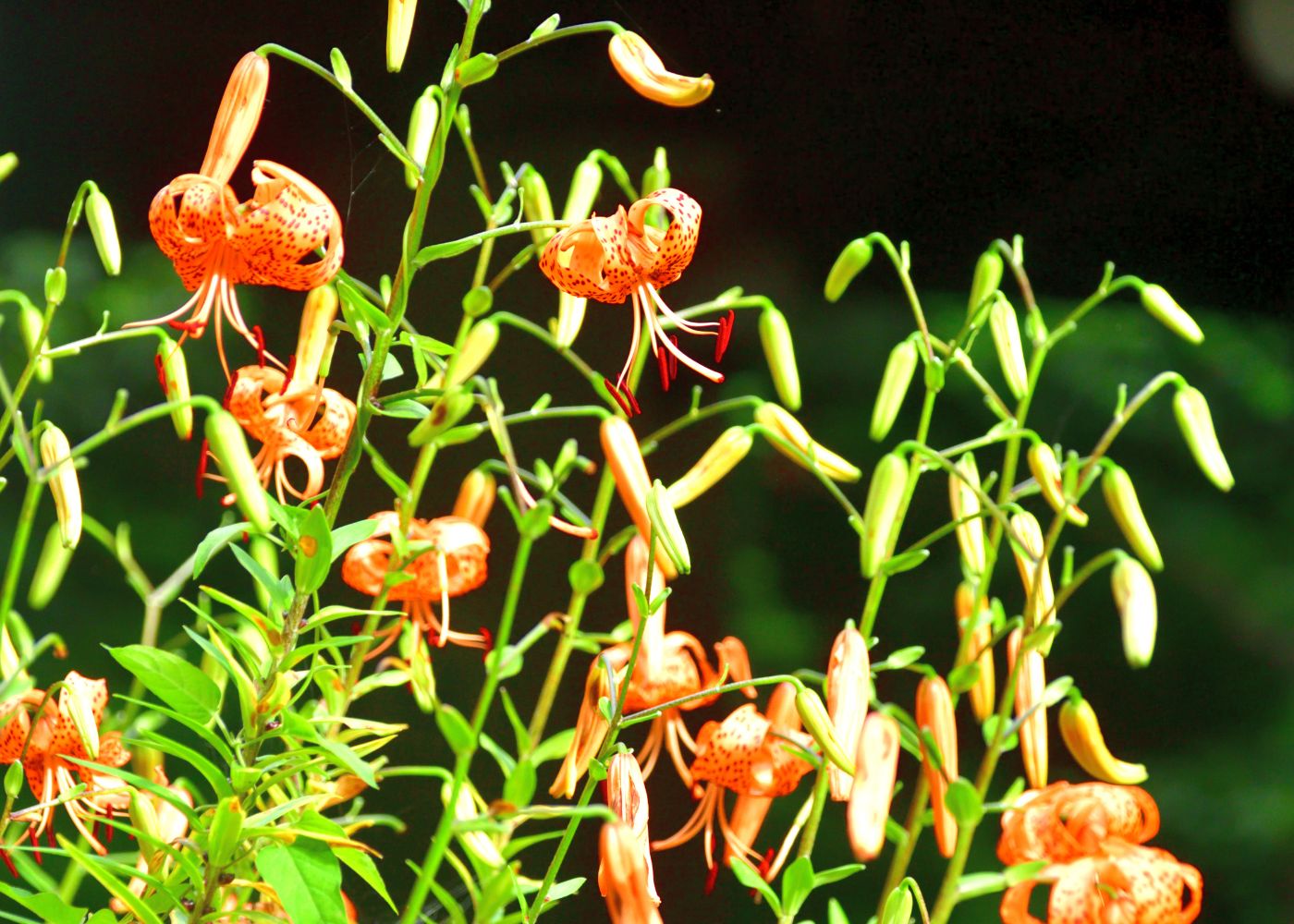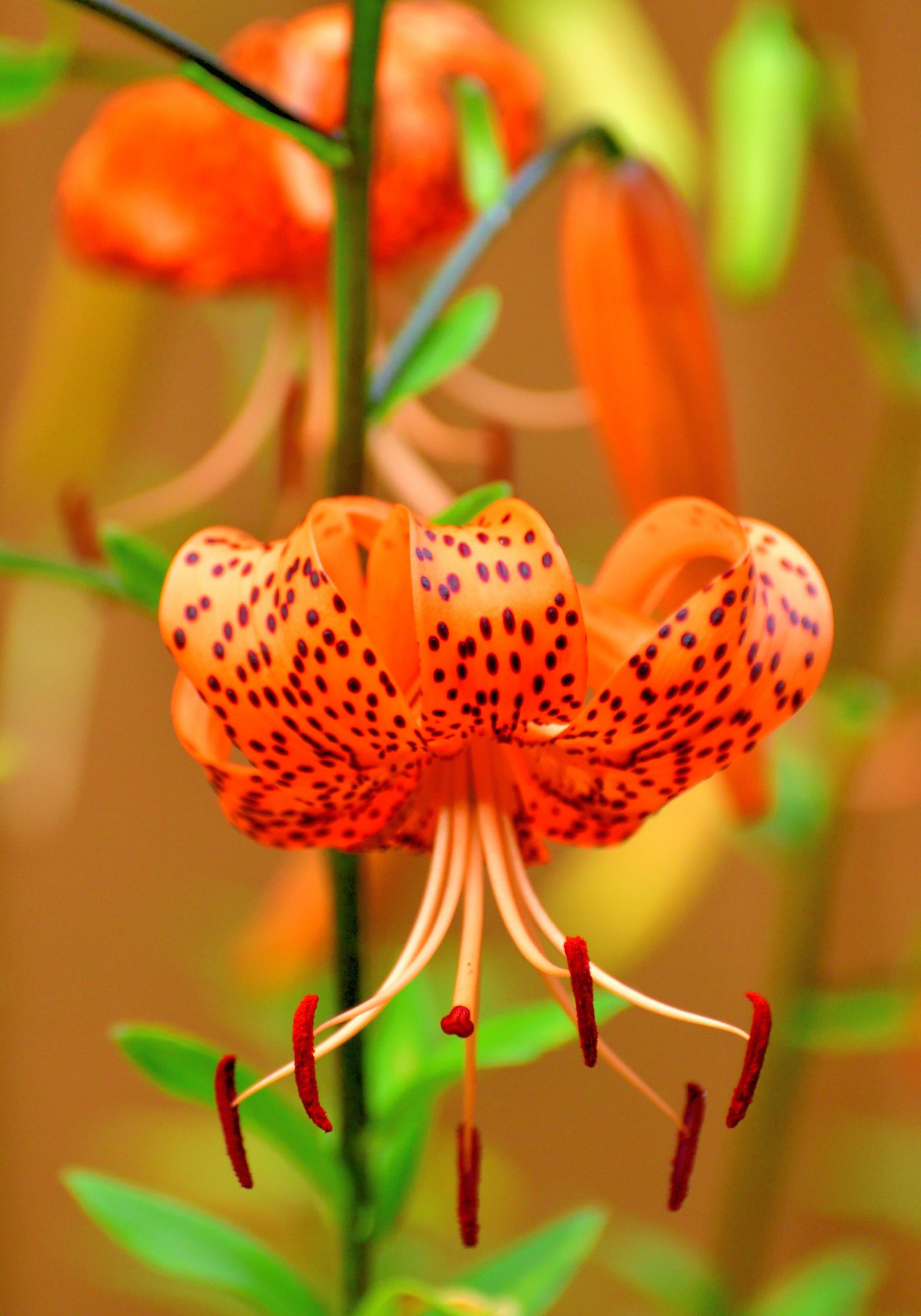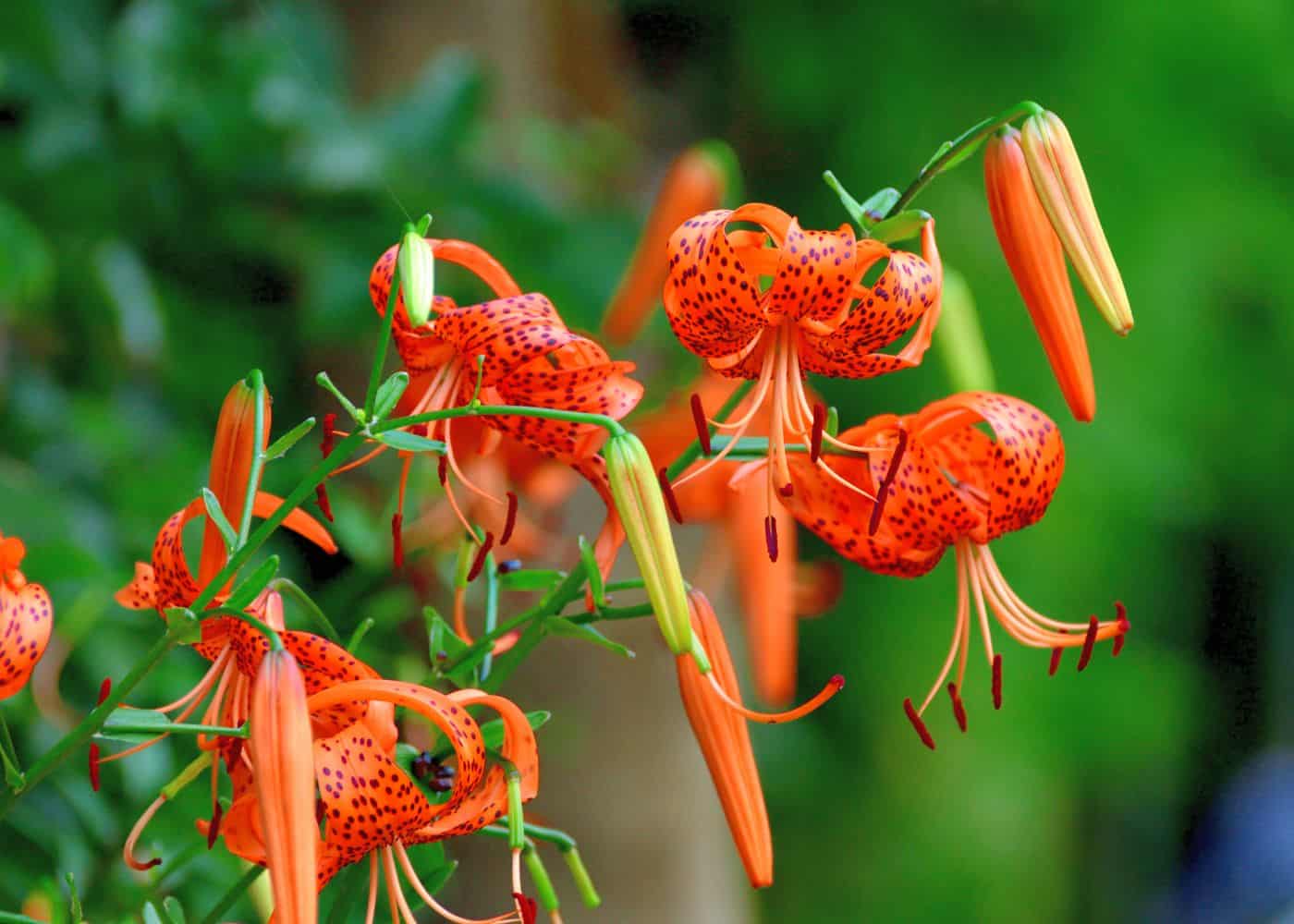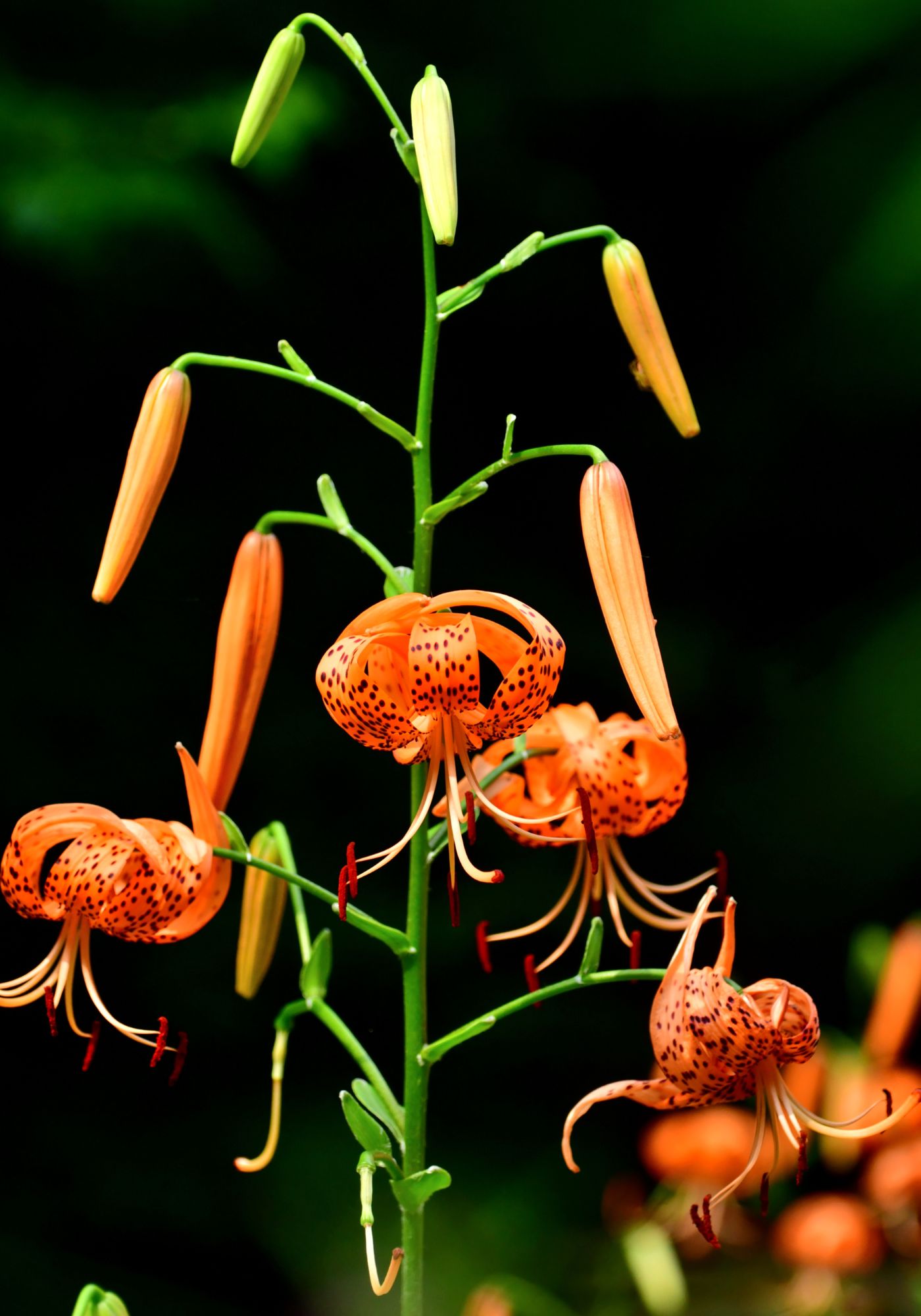Interested in growing tiger lily flower? These lovely lilies are surprisingly easy to plant and care for in the garden!
Tiger lily flower (Lilium lancifolium) is a herbaceous perennial plant known for its distinctive orange flower petals with delicate dark spots. This lily species is native to eastern Asia and symbolizes wealth and confidence. Tiger lilies typically bloom in late spring with a prolific display of flowers. The plants are generally easy to grow and flower best when planted in well-drained soil and in a full sun location.

Introduction to the Tiger lily flower
The tiger lily flower (Lilium lancifolium) is a flowering herbaceous perennial plant. Tiger lilies are a very popular garden plant due to their elegant, exotic orange flowers. And fortunately for gardeners, they’re also quite easy to grow.
Tiger lilies grow from fleshy underground bulb-like roots. The plants are perennials in Zones 3-7, dying back to the soil line each autumn after the first freeze. New growth appears in the springtime, with foliage usually reaching about 2 feet tall and the thin flower stalks reaching up to about 4 feet tall. Each stem usually has 6-9 flowers.
Like most kinds of lilies, tiger lilies are tolerant of many different soil types, including slightly alkaline to acidic soils. The tiger lily flower is native to eastern Asia, including regions of China, Japan, Korea, Tibet, and the Russian islands of Sakhalin and Kuril. It is well-adapted as a garden plant and is grown in ornamental gardens around the world.

Planting tiger lilies
Tiger lilies can be planted from bulbs or purchased as potted plants. If planting from bulbs, choose a well-drained, sunny site and plant them 5-6 inches deep. If planting from a potted lily plant, choose a site with similar conditions – it should have good drainage, full sun, and fertile soil. The best times of year to plant lilies are in early spring and in the fall.
Caring for tiger lilies
Tiger lilies require plenty of sunshine and rich, fertile soil that drains well. For best results, tiger lilies should be planted in a location that gets full sun (at least 6 hours of direct sunlight each day). They also prefer slightly acidic soil with a pH between 5.5 and 7.0.
Watering tiger lilies
Tiger lilies need regular watering, especially during periods of hot weather. Water tiger lily plants at the base of the plant and avoid getting water on the foliage or flowers. Water tiger lilies deeply but infrequently to ensure that their roots are well hydrated. Be sure not to over-water tiger lilies, as too much water can cause root rot.
Fertilizing tiger lilies
Tiger lilies benefit from regular fertilization to ensure they have the nutrients they need to thrive. Feed tiger lilies with a balanced fertilizer every four weeks throughout the growing season. Be sure to follow the instructions on the fertilizer label for the correct amount and frequency.
Deadheading tiger lilies
Tiger lilies should be deadheaded (removing spent flowers) regularly to encourage more blooms and to keep the plant looking neat. Deadheading also prevents tiger lilies from going to seed, which will reduce their vigor over time.

Planting tiger lilies
Tiger lilies are usually planted either from dormant bulbs/roots during the cooler months or as a potted plant during the growing season.
Where to plant tiger lilies
Whether you’re planting from bulbs or with a potted plant, the site selection is the same. Look for an area in full sun, meaning it gets a minimum of 6-8 hours of direct sunlight each day. Tiger lilies need plenty of sunlight to flower at their best. The soil should also be fertile and well-drained, as tiger lilies will rot in wet or poorly drained soil.
How to plant tiger lily bulbs
Here are the basic steps to plant tiger lily bulbs in your garden so you can enjoy these beautiful flowers for years to come.
- Prepare the soil: Before planting, remove any weeds or plant debris from the planting area. While not completely necessary, you can also improve the soil across the planting area if it is poor. Tiger lilies tolerate a wide range of soil types, from sandy to clay, but they may appreciate some organic matter dug into the soil to a depth of about 6-8 inches.
- Dig planting holes: Most tiger lily bulbs can be planted in holes about 6 inches deep. There is some variation in bulb size, so read the bulb package and take your individual variety into account. In general, the planting hole for spring bulbs is generally dug to a depth of 2-3 times the bulb’s width at the widest point. Gardeners with colder winters tend to plant on the deeper end of this range. In terms of spacing between holes, most varieties can be planted about 12 inches apart, but you can plant them closer for a full effect sooner.
- Add bulb food: As an optional step, you can add a bit of natural bulb food to the bottom of the planting hole.
- Plant the bulbs: Plant the tiger lily bulbs with the pointy side up and the flat side with the roots down . Make sure the bulbs are planted at the correct depth and spaced far enough apart to allow room for the roots to grow.
- Cover the bulbs with soil: Gently fill the planting hole with soil and press it down around the tiger lily bulbs.
- Water: Water the bulbs after planting to help settle the soil around them. After that, keep the soil consistently moist, but not waterlogged.
- Mulch: After the soil has warmed up in spring, you can apply a layer of mulch to the soil to help retain moisture and suppress weed growth.
- Fertilize: Tiger lilies can benefit from fertilizer applications. Fertilize early in the growing season when the foliage starts to appear, and optionally feed again right after the plant finishes flowering.
- Wait for blooms: After planting your tiger lilies, it will usually several months before they bloom, depending on the variety and the local weather conditions. There will likely not be too many flowers in the first year, but with proper care, the tiger lilies will bloom each year and will slowly multiply over time to create a beautiful display in your garden.
- Maintain: Once the lilies are established, they are relatively low maintenance. Be sure to remove any yellow or brown leaves as they appear and deadhead the spent blooms to encourage more blooms.
By following these steps, you can successfully plant tiger lily bulbs in your garden and enjoy their beautiful flowers for years to come. Remember, to take good care of them and provide the best growing condition will help them to thrive and bloom.

How to plant a potted tiger lily in a garden bed
Planting a potted tiger lily in your flower garden is a bit different from planting bulbs, but the process is still relatively simple. Here are the steps you should follow:
- Prepare the soil: Loosen the soil in the area where you plan to plant the lily to a depth of about 6 inches and add some organic matter, such as compost or well-rotted manure, to the soil. This will help improve the soil’s drainage and fertility.
- Remove the plant from the pot: Gently remove the plant from the pot. Take care not to damage the roots, but it is ok to disturb the soil around them. If the soil is too dry and the root ball is stuck in the pot, you may need to soak the pot in water for a few minutes to loosen the soil.
- Plant the lily: Dig a hole that is about twice as wide as the root ball and only deep enough so that the base of the plant is at the same level as the surrounding soil. Gently place the root ball in the hole. If there are tight white roots circling around the root ball, gently loosen them up and arrange them in the hole so the roots point away from the base of the plant. Then backfill the soil around it, making sure to firm the soil around the base of the plant.
- Water the plant: Water the plant well after planting to help settle the soil around it. Keep the soil consistently moist, but not waterlogged, until the lily is established.
- Mulch: Apply a layer of mulch to the soil to help retain moisture and suppress weed growth. A good option is composted yard trimmings.
- Wait for blooms: Tiger lilies can take a few weeks to several months to bloom, depending on the stage at which the plant was when you planted it, the variety, and local weather conditions. With proper care, the tiger lilies will bloom each year and will slowly multiply over time, creating a beautiful display in your garden.
- Fertilize: Tiger lilies can benefit from fertilizer applications. Fertilize early in the growing season when the foliage starts to appear, and optionally feed again right after the plant finishes flowering.
- Maintain: Once the lilies are established, they are relatively low maintenance. Be sure to remove any yellow or brown leaves as they appear and deadhead the spent blooms to encourage more blooms.

How to care for tiger lily flower plants in the garden
Tiger lilies are a beautiful and easy-to-grow addition to any garden. With their large, showy flowers and sturdy stems, they are a great choice for both novice and experienced gardeners. However, to ensure that your tiger lilies thrive and bloom each year, it’s important to provide them with proper care. In this blog post, we’ll go over the steps to care for tiger lily flower plants in your garden.
Watering tips
Tiger lilies need to be kept consistently moist, but not waterlogged. Water them deeply and regularly, especially during dry periods. Avoid overhead watering to prevent fungal diseases that can damage the leaves and flowers. These plants do much better with drip irrigation lines or hand watering at the plant’s base.
Fertilizing tips
Tiger lilies can benefit from fertilization. Fertilize once a month with balanced fertilizer, or when the first leaves appear during the growing season. This will help promote healthy growth and more blooms. Avoid high-nitrogen fertilizers which can lead to an abundance of foliage without many flowers
Mulching tips
After the soil has warmed up in spring, you can apply a layer of mulch to the soil to help retain moisture and suppress weed growth. This will also help to keep the base of the plants cool during summer and warmer during the winter. You can reapply organic mulch in the fall if you like.
Pruning tips
Remove any yellow or brown leaves as they appear and deadhead the spent blooms to encourage more blooms. This will also help to prevent the plant from expending energy on seed production and instead focus on growing and blooming.
Staking tips
As the plants grow taller, they may become top-heavy and prone to falling over. While they are usually about 4 feet tall, sometimes the flower stems can reach 6 feet tall. At this point, they can snap over under their own weight or in the wind. You can prevent this by staking them with bamboo or metal stakes. Gently tie the flower stalks to the stakes with twine or soft fabric. This will help to support the stems and keep the flowers upright.
Dividing and transplanting
If your tiger lilies become overcrowded or if you want to move them to a new location, it’s best to divide and transplant them in early spring when the plants are still dormant. Make sure to choose a spot that has well-drained soil and gets full sun and transplant them at the same depth they were growing at before. While early spring is best, lilies are quite tough and can usually be transplanted (carefully) whenever the soil isn’t frozen.
Disease control
Tiger lilies are generally quite hardy and pest-free, but they can be affected by certain diseases such as botrytis or lily mosaic virus. If you notice any signs of disease, such as discolored leaves or stunted growth, it’s best to remove the affected plant and destroy it to prevent the spread of the disease. Tiger lilies tend not to show the symptoms of lily virus as other species do, so avoid planting non-certified plants in your garden if you have other types of vulnerable lilies.
By following these care tips, you can ensure that your tiger lily flower plants thrive and bloom each year. Remember that different varieties of tiger lilies may have specific care requirements and that the local weather conditions can also play an important role in the plants’ growth and development.
It’s always important to remember that different varieties of tiger lilies may have specific care requirements and that the local weather conditions can also play an important role in the plants’ growth and development. If you have any specific questions about your plants, consult a gardening expert or your local nursery for further advice.

FAQs about tiger lily flowers
Here are some common questions that people often have about tiger lily flowers:
What is the best time to plant tiger lily bulbs?
The best time to plant tiger lily bulbs is in early spring or in the fall. The bulbs are usually easier to find in garden centers in the spring, but some specialty sellers ship them in the fall.
How much sun do tiger lilies need?
Tiger lilies prefer full sun but are also tolerant of partial shade. The plants will not flower well if they do not get enough direct sunlight.
How often should I water tiger lilies?
When first planted, tiger lilies need to be kept consistently moist, but not waterlogged. Water them deeply and regularly, especially during dry periods. Once the plants are established, they are more tolerant to drought.
How do I divide and transplant tiger lilies?
It’s best to transplant tiger lilies in early spring when the plants are still dormant. Carefully dig around the clumps, being careful not to damage the bulbs, and divide the clumps. Replant the healthy bulbs in a new location.
What is the meaning of tiger lily flower?
Tiger lilies symbolize wealth and prosperity and they also can symbolize pride and confidence. Also, they are often used as a symbol of motherhood.









